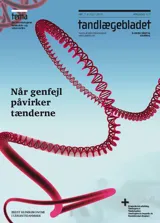De Odontologiske Landsdels- og Videncentre 2002-2012
På baggrund af en ændring i tandplejeloven (2001) blev der oprettet odontologiske landsdels- og videncentre ved hhv. Rigshospitalet (RH) og Aarhus Universitetshospital (AUH). Centrene har nu fungeret i mere end 10 år, og det er artiklens formål at beskrive videncentrenes virksomhed i denne periode. De odontologiske videncentre er etableret på de Kæbekirurgiske afdelinger og fungerer i et tæt samarbejde med de to tandlægeskoler. Målgruppen for videncentrene er dels patienter med sjældne medfødte sygdomme, dels patienter med sjældne tandanomalier. I løbet af 10-årsperioden er der modtaget 1.827 henvisninger, hvoraf hovedparten af patienterne er under 20 år. Der er tale om patienter med i alt ca. 100 forskellige medfødte sjældne sygdomme, medens svære tilfælde af agenesi eller amelogenesis imperfecta udgør hovedparten af de dentale anomalier. Patienter kan modtage højtspecialiseret behandling i videncenterregi, som udføres i samarbejde mellem de kæbekirurgiske afdelinger og de odontologiske institutter i landet. Videncentrene har engageret sig i forskning af en række relevante emner og dermed bidraget til øget indsigt i de pågældende områder. Den oparbejdede ekspertise samt et omfattende dokumentationsmateriale i videncentrene anvendes i formidling af viden om odontologiske forhold ved sjældne tilstande. Målgruppen for denne formidling er såvel fagfolk (de odontologiske grunduddannelser samt tandlægers efter- og videreuddannelser) som lægfolk (patientforeninger).
Ten years with Danish centres of oral health in rare diseases
At the University Hospital of Copenhagen and Aarhus, centres of excellence for oral health in rare diseases were established as a consequence of a revision of the law on the dental service in Denmark (2001). The centres have now been functioning for ten years and it is the aim of the present article to describe the activities of the centres during this period. The centres are placed at the Departments of Maxillofacial Surgery and they collaborate closely with the Departments of Dentistry at the Universities of Copenhagen and Aarhus. Patients with rare, inherited diseases as well as patients with rare dental anomalies are the main groups which can be referred to the two centres. During the ten year period, the centres have received 1,827 referrals of which the majority were referrals of patients below the age of 20 years. Approximately 100 different diagnoses of rare diseases have been recorded. Among dental anomalies, multiple agenesis and amelogenesis imperfecta are dominant. In the centres, patients receive specialized dental treatment when indicated. This type of treatment is performed in collaboration between the Departments of Maxillofacial Surgery and the Departments of Dentistry at the universities. The centres have been engaged in research upon different topics with relevance to the patients referred to the centres. The documentation of patients referred to the two centres has been the basis for centralized building of knowhow, which is a prerequisite for the education on oral health in rare diseases offered by the centres. Both professionals and lay people have received education from the centres.


